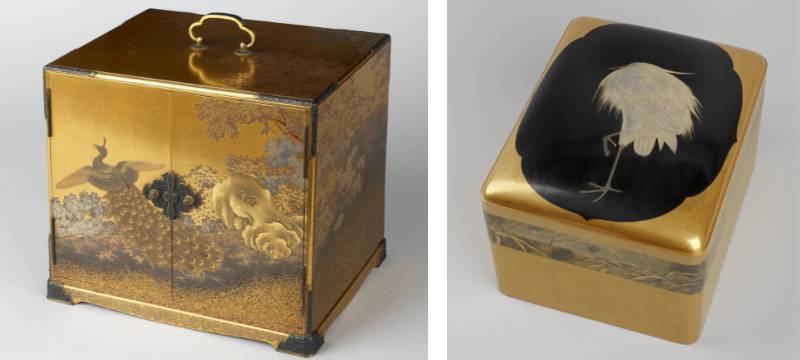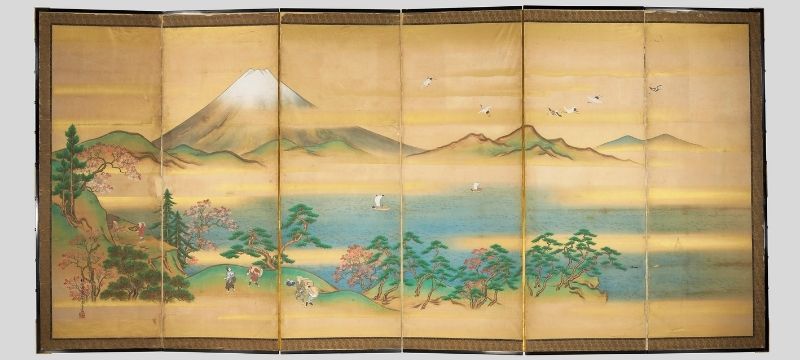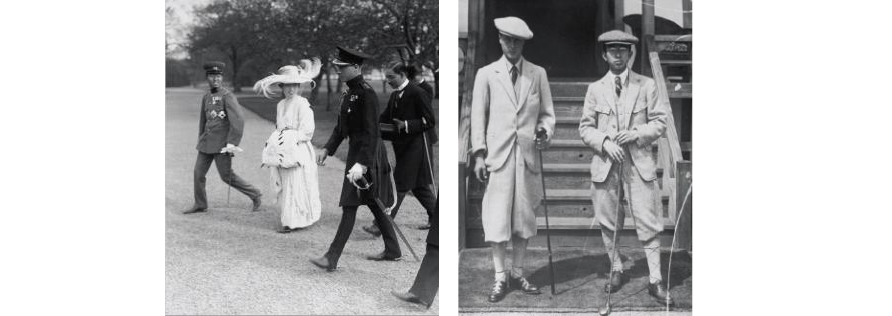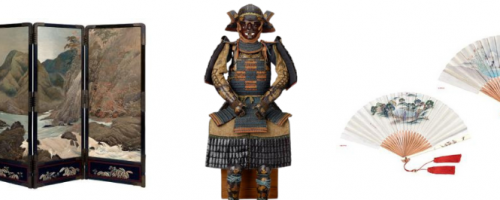Royal Collection Trust/© Her Majesty Queen Elizabeth II
The first samurai armour ever seen in Britain, splendid coronation and jubilee gifts presented to monarchs from Queen Victoria to Her Majesty The Queen, and a never-before-seen woodcut print of Buckingham Palace are among the highlights of the new exhibition Japan: Courts and Culture, which has opened at The Queen’s Gallery, London.
The Royal Collection holds some of the finest examples of Japanese art and design in the western world. For the first time, more than 150 works have been brought together to tell the story of 350 years of diplomatic, artistic and cultural exchange between Britain and Japan, from first encounters under James I to the modern partnership of The Queen’s reign.
The exhibition displays together for the first time all four suits of samurai armour in the Royal Collection. These include an armour sent to James I in 1613 by Japan’s military leader – the first known samurai armour to arrive on British soil and the first diplomatic gift between Japan and Britain. Other rare examples of arms and armour include the only Field Marshal’s sword known outside Japan and a dagger with fittings personally designed by the Emperor Meiji, the first ruler of the Empire of Japan.

Royal Collection Trust/© Her Majesty Queen Elizabeth II
Exquisite gifts presented by the Japanese Imperial Family to mark the coronations and jubilees of British monarchs will be on display, many for the first time, including an embroidered folding screen sent to Queen Victoria by the Emperor Meiji for her Diamond Jubilee in 1897. A miniature lacquer cabinet, presented to Queen Mary for her Coronation in 1911, bears the Imperial chrysanthemum crest and opens to reveal drawers decorated with mother-of-pearl butterflies. It was created by Akatsuka Jitoku, one of the most accomplished lacquerers of his generation. Only a dozen or so of his works are known outside Japan.
On the occasion of Queen Elizabeth’s coronation in 1953, the Emperor Shōwa (Hirohito) sent The Queen the first post-war diplomatic gift between the two nations: a box decorated with a delicate silver heron by the great lacquer artist Shirayama Shōsai. Nearly 70 years later, as the nation celebrates the Queen’s Platinum Jubilee, visitors to The Queen’s Gallery will have the opportunity to see this exquisitely crafted Coronation gift up close.

Gifts were also sent to mark treaties between the two nations. A pair of colourful folding screen paintings, recently rediscovered and on display for the first time, were sent to Queen Victoria by Shōgun Tokugawa Iemochi in 1860 to mark the first treaty between Japan and Britain for almost 250 years. The gift also included glittering mother-of-pearl spears, lacquer furniture, swords by leading court swordsmiths, and porcelain saké bottles that still contain traces of their original contents, all of which feature in the exhibition.
First-hand accounts demonstrate the wonder felt by the earliest British royal visitors to Japan. In 1869, Prince Alfred, Duke of Edinburgh, became the first European royal to visit modern Japan. He wrote to his mother: “To give you any account of this country, I feel quite at a loss. Every thing is so new & so quaint that I am quite bewildered.” The future King George V visited with his brother in 1881, and the official tour diary states that the teenage princes had their arms tattooed during their visit – Albert Victor with “a couple of storks” and George with a tiger and a dragon, a combination said to signify East and West.

Royal Collection Trust/© Her Majesty Queen Elizabeth II
Exactly 100 years ago, in April 1922, the future King Edward VIII made a month-long official visit to Japan. Photographs from his tour, on display for the first time, demonstrate the close relationship that he was said to have formed with Crown Prince Hirohito. The two heirs to the throne were close in age and could converse in French, and were even photographed by the press dressed in similar tweed suits and plus fours to enjoy a round of golf together.
Queen Mary was perhaps the most enthusiastic royal collector of Japanese art. Highlights on display from her collection include delicate folding fans and colourful woodcut floral prints. An atmospheric woodcut print of Buckingham Palace at dusk, on display for the first time, was presented to Queen Mary in 1928 by Makino Yoshio, one of the most celebrated Japanese artists in Britain at the time. The print perfectly represents this period of growing artistic exchange: an iconic British landmark, depicted in a traditional Japanese medium.
This spirit of artistic exchange can also be found in the most recent work to feature in the exhibition: a vessel by the artist-potter Hamada Shōji, who in 1955 was honoured by the Imperial Government as a ‘Holder of Important Intangible Cultural Properties’ or ‘Living National Treasure’. In the 1920s, Shōji had collaborated with the British potter Bernard Leach at his studio in St Ives, Cornwall. The vessel was presented to The Queen during her State Visit to Japan in 1975 (the first visit by a reigning British monarch), and Her Majesty in turn gave a stoneware plate and etching by Leach, in recognition of the two potters’ lifelong partnership.
Rachel Peat, curator of Japan: Courts and Culture said, “We are delighted to give visitors a rare chance to see these stunning works from Japan, which have been marvelled at, displayed and cherished by members of the British royal family for centuries. It’s a real opportunity to see first-hand the precious materials and intricate techniques which have so profoundly shaped British taste and which helped forge a lasting relationship between the two nations. We hope visitors will enjoy discovering the worlds of ritual, honour and artistry that link the courts and cultures of Britain and Japan to this day”.
For more information visit the Japan: Courts and Culture website.










